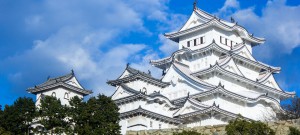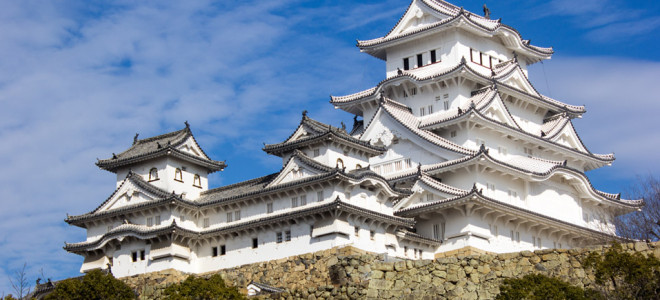Himeji Castle is predicted to welcome a whopping two million visitors this year after its post-restoration reopening on March 27th. Perched upon a hill where its towers can be seen for miles, the picturesque fortress is nicknamed Shirasagi-jo (“White Heron Castle”) or Hakuro-jo (“White Egret Castle”) because of its brilliant, white exterior and unique tower structuring. It wields a commanding view of the city and leaves a lasting impression on all who journey to see it. Film aficionados will instantly recognize it from the James Bond movie You only Live Twice (1967), and from AkiraKurosawa’s Kagemusha (1980), and Ran (1985). This World Heritage Site is the epitome of the feudal Japanese castle and the largest, best-preserved of all its counterparts across the nation. The newly-restored structure is truly a sight to behold, but the stories of how this now national treasure survived multiple demolition plans, earthquakes, and even a World War II bomb are as surprising as the castle is enchanting.
History and Style
 Himeji Castle itself has gone through many incarnations dating back to 1333, being rebuilt and remodeled by various daimyo (feudal lords). The current form we see today is over 400 years old. After the the pivotal battle of Sekigahara in 1600, which saw power shift to Tokugawa Ieyasu and the eventual beginnings of the Edo Period (1603–1868), Ieyasu awarded the castle to his son-in-law, Ikeda Terumasa. In 1601 Terumasa overhauled the castle and rebuilt it completely, finishing it in 1609. The new fortress was in the nowiconic Azuchi-Momoyama style.
Himeji Castle itself has gone through many incarnations dating back to 1333, being rebuilt and remodeled by various daimyo (feudal lords). The current form we see today is over 400 years old. After the the pivotal battle of Sekigahara in 1600, which saw power shift to Tokugawa Ieyasu and the eventual beginnings of the Edo Period (1603–1868), Ieyasu awarded the castle to his son-in-law, Ikeda Terumasa. In 1601 Terumasa overhauled the castle and rebuilt it completely, finishing it in 1609. The new fortress was in the nowiconic Azuchi-Momoyama style.
The new design was in response to the introduction of firearms in Japan in 1543. It is distinctively characterized by a musha-gaeshi (large stone base), with large, complex maru (baileys) and a daitenshu (main keep). These changes gave significant protection and tactical advantage to the daimyo and their armies. Himeji-jo is the perfect personification of this design, standing today as the finest example of 17th-century Japanese architecture. It is a designated kokuhou (a national treasure of Japan) and was named a UNESCO World Heritage Site in 1993.
Structure and Defenses
As formidable as it is elegant, Himeji Castle was built incorporating a plethora of tricks and defensive structures. One of the keys to the castle’s defenses is its elaborate maze system, which possesses many disorienting pathways. With 84 gates (21 of which still exist) and three moats (only the inner moat exists now) working in tandem with the baileys and outer walls, an enigmatic labyrinth was created that is known to still confuse tourists today, even with signs posted!
One deceptive gate in particular gives the appearance that the main tower is very close, when in fact following the path that winds through it takes you away from the main keep. Conversely, another gate provides a correct pathway to the central tower, but will deceive an unwitting visitor by seemingly taking them down and away from it.
Roughly 1,000 sama (loopholes) are littered around the castle for archers and armed guards with matchlocks to harass any would-be intruders, as well as a variety of ishiotoshi (angled chutes) from which stones or boiling water could be cast down on the enemy. This explains why, in its more than 400- year history, no one dared to attack Himeji Castle.
The Lucky Castle
At least three strokes of mighty good luck have fallen upon Himeji Castle at crucial points in its past when circumstances almost rendered it solely to the history books – torn down, demolished, or bombed into non-existence.
The ushering in of the new Meiji Period (1868–1912) signaled the end of the significance of Japanese castles. During the Meiji era, surviving castles were considered great burdens to upkeep because of the cost. The government also wanted these prestigious symbols of the former regime to be removed and forgotten, ordering all castles to be sold and demolished. Many castles were torn down and Himeji Castle was slated to share this same fate.
In 1869, the government auctioned the castle off and a man named Mr. Kanbe bought it for 23-and-a-half yen. A bargain even in those days, the amount is estimated at around ¥200,000 in today’s currency. He was a developer and planned to clear the land, but found it was too expensive to level the giant castle.
“The white heron turned into a white elephant,” joked volunteer guide Kenji Miyazaki.
The castle narrowly escaped destruction again a few years later in 1871. During this year, some of the corridors and gates were leveled to make room for modern military barracks, and there were plans to expand these on the castle grounds. If not for the last-minute intervention of Colonel Nakamura Shigeto, who convinced the army chief to leave it, the castle would have been torn down.
Himeji-jo escaped ruin yet again during World War II when Himeji was heavily bombed with much of the city being destroyed. A fire bomb was dropped directly on Himeji Castle, and somehow, the bomb did not go off. This White Heron Castle prevailed once more while so much around it perished.
The castle even stood up to the Great Hanshin Earthquake in 1995, receiving very little damage.
“Despite it being such a powerful earthquake, even the bottle of sake on the altar at the top floor remained in place. The sake was an offering to the gods, so the gods’ sake was OK,” Mr. Miyazaki smiled.
Who says you only live twice?
Getting There
Himeji Castle’s main keep will be opened to the public from Fri, Mar 27
• Access: JR Himeji Stn, Central Exit, 10-min walk
• Admission: (From Mar 27) Adults ¥1,000, Kids ¥300
• Open: 9:00am–4:00pm (gate closes at 5:00pm)
• Tel: 07-9285-1146
